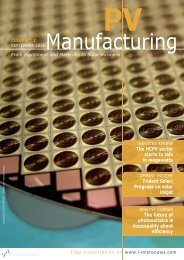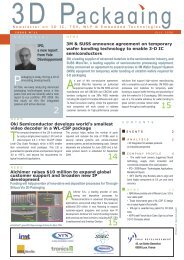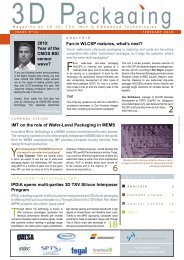issue n°139 - I-Micronews
issue n°139 - I-Micronews
issue n°139 - I-Micronews
You also want an ePaper? Increase the reach of your titles
YUMPU automatically turns print PDFs into web optimized ePapers that Google loves.
10 | ISSUE N°139 | 7/02/13<br />
IMAGING<br />
Opgal introduces EyeCGas Camera System for remote gas detection<br />
Opgal answers the needs of the petro and drilling industry’s gas leak detection requirements with its EyeCGas Camera System. EyeCGas, an innovative,<br />
unique gas detection camera, has already achieved worldwide success for remotely detecting gas in the industrial environmental market.<br />
The oil & gas industry continues to face<br />
increasing safety and environmental<br />
constraints, driving stricter regulations.<br />
The recent discovery of significant gas reserves<br />
off the coasts of Israel is just one example of<br />
this growing <strong>issue</strong>. But the case of the city of<br />
Haifa shows that Opgal’s camera addresses<br />
other environmental hazards beyond those of<br />
gas exploration and production.<br />
Benzene, a component of gasoline, is known<br />
as a potential contributor to the development<br />
of human cancer. Dr. Ofer Dressler , the<br />
Director General of the Haifa Bay Urban<br />
Association for Environmental Protection,<br />
states that «Petrol stations in the Haifa Bay<br />
contribute about 15% of the benzene<br />
emissions in the area as well as other toxins.<br />
It’s critical that we continuously monitor these<br />
stations.» The Haifa Bay Urban Association for<br />
Environmental Protection has given top<br />
priority to detecting the harmful gas. Opgal’s<br />
EyeCGas provides a solution to this potential<br />
problem as it is used to monitor more than<br />
100 petro stations located within the city of<br />
Haifa and will soon also monitor petrochemical<br />
plants in the Haifa Bay area.<br />
EyeCGas, equipped with a 75mm lens, is the<br />
only camera of its kind in the world that has<br />
been certified for use in sensitive and<br />
hazardous locations according to American<br />
and European standards (ATEX, CSA, UL). The<br />
camera’s impressive performance has earned<br />
worldwide accolades and has been sold to<br />
dozens of companies around the world through<br />
its inter national network of specialized<br />
partners and marketing channels.<br />
Opgal’s EyeCGas camera technology is based<br />
on a unique infrared sensor and algorithms<br />
that enable detection of multiple types of<br />
hydrocarbon vapors, viewing them as a clear<br />
video image on an LCD screen and recording<br />
those video images together with an<br />
associated audio narration. Assessments<br />
conducted by third party laboratories have<br />
proven the camera’s sensitivity way beyond<br />
EyeCGas Camera System (Courtesy of Opgal)<br />
the minimum EPA requirement of 60 grams<br />
per hour. EyeCGas detects methane levels as<br />
low as 0.35 grams per hour.<br />
www.opgal.com<br />
Cost-effective process to improve performance of<br />
CMOS sensors<br />
Image sensors are at the core of every digital camera. Before a snapshot<br />
appears on the display, the sensors first convert the light from the lens<br />
to electrical signals. The image processor then uses these to create the<br />
final photo.<br />
Ultra-thin: Organic sensors can be<br />
applied to CMOS chips over large and<br />
small surfaces, as well as to glass or<br />
flexible Ultra-thin: Organic sensors can be<br />
applied to CMOS chips over large and small<br />
surfaces, as well as to glass or flexible plastic<br />
films.<br />
Many compact and cellphone cameras contain<br />
silicon-based image sensors produced using<br />
CMOS (complementary metal oxide<br />
semiconductor) technology. Prof. Paolo Lugli<br />
and Dr. Daniela Baierl from TUM have<br />
developed a cost-effective process to improve<br />
the performance of these CMOS sensors.<br />
Their approach revolves around an ultra-thin<br />
film made of organic compounds, in other<br />
words plastics.<br />
The challenge lay in applying the plastic<br />
solution to the surface of the image sensors.<br />
The researchers tested spin- and spraycoating<br />
methods to apply the plastic in its<br />
liquid, solution form as precisely and costeffectively<br />
as possible. They were looking for<br />
a smooth plastic film that is no more than a<br />
few hundred nanometers thick. Spray-coating<br />
was found to be the best method, using either<br />
a simple spray gun or a spray robot.<br />
Organic sensors have already proven their<br />
worth in tests: They are up to three times<br />
more sensitive to light than conventional<br />
CMOS sensors, whose electronic components<br />
conceal some of the pixels, and therefore the<br />
photoactive silicon surface.<br />
Organic sensors can be manufactured without<br />
the expensive post-processing step typically<br />
required for CMOS sensors. Every part of<br />
every single pixel, including the electronics,<br />
is sprayed with the liquid polymer solution,<br />
giving a surface that is 100 percent lightsensitive.<br />
The low noise and high frame rate<br />
properties of the organic sensors also make<br />
them a good fit for cameras.<br />
Another advantage of the plastic sensors is<br />
that different chemical compounds can be<br />
used to capture different parts of the light<br />
spectrum.<br />
www.tum.de<br />
Collection of customs duty on image sensors<br />
suspended<br />
FRAMOS eliminates cost factor for European industry.<br />
FRAMOS has achieved a Europe-wide<br />
suspension of customs duty on CMOS<br />
image sensors with the support of two<br />
members of the German Bundestag (lower<br />
house of parliament) and the industrial<br />
association VDMA. Allocating imported goods<br />
into the correct customs tariff class is a<br />
complicated task, especially when a range of<br />
applicable tariff groups exist. A typical<br />
example in this regard is the correct<br />
allocation of imaging sensors, especially CCD<br />
and CMOS sensors.<br />
As all of the main functional assemblies are<br />
housed on a chip, it is reasonable to allocate<br />
CCD and CMOS to tariff group 8542 for<br />
“Integrated circuits” and thus to account for<br />
them as exempt from duty. However, the<br />
usual interpretation applied by customs<br />
officials is that this tariff group is not<br />
applicable to these components, since almost<br />
all sensors commonly used nowadays also<br />
contain purely optical elements (micro lenses,<br />
colour filters) without an electrical input or<br />
output signal.<br />
Under this interpretation, such an imaging<br />
sensor is not an integrated circuit. Instead,<br />
the sensors are to be allocated to tariff group<br />
“8529 – Parts for television cameras” and are<br />
therefore subject to a hefty rate of duty. A<br />
customs duty suspension has already been in<br />
place for special CCD sensors within the<br />
applicable customs tariff number 85.29 9092<br />
since 2010. As the technical description<br />
broadly applies both to CCD and to CMOS<br />
within the scope of this customs duty<br />
suspension, the FRAMOS Group, one of the<br />
biggest European importers of image sensors,<br />
filed an application to have the customs duty<br />
suspension extended to cover CMOS sensors.<br />
This application was approved with effect<br />
from 1 January 2013.<br />
The prevalence of CMOS sensors has<br />
increased in virtually every relevant branch<br />
of industry in recent years. The automotive<br />
industry, in particular, is increasingly reliant<br />
on imaging techniques and extensively on<br />
CMOS technology. The trend is also sharply<br />
upwards in the areas of quality assurance,<br />
process automation and medical technology.<br />
www.framos.com<br />
Two day conference plus expert<br />
pre-conference workshops and<br />
innovation platforms<br />
IMAGE SENSORS 2013<br />
FOCUS ON DIGITAL IMAGING<br />
19-21 March, Park Plaza Victoria, London<br />
image-sensors.com<br />
This year’s Image Sensors agenda has now been released.<br />
The programme includes 14 brand new speakers, including:<br />
ZOOM<br />
Embedded vision boosts<br />
driver-assistance designs<br />
By Tom Wilson, CogniVue Corp.<br />
Forward facing Advanced Driver<br />
Assistance Systems (FF ADAS) are<br />
becoming increasingly important,<br />
especially as the European New Car<br />
Assessment Programme (Euro NCAP)<br />
ratings are tied to AEB (Autonomous<br />
Emergency Braking) and other important<br />
car safety features. Euro NCAP recently<br />
announced a new rating scheme for the<br />
years 2013 to 2017, which is also driving<br />
ADAS trends for players across the<br />
automotive market, from tier 1s and<br />
manufacturers, to semiconductor<br />
suppliers.<br />
ADAS applications such as AEB and Lane<br />
Departure Warning (LDW) will be taken<br />
much more strongly into account by 2014,<br />
and will be key for achieving a top Euro<br />
NCAP 5-star rating, which significantly<br />
impacts car manufacturers’ sales rates.<br />
image-sensors.com<br />
Book now to save 15%, quote ‘AD15M’<br />
Dr Howard E Rhodes, Chief Technical<br />
Officer, OMNIVISION, USA<br />
Jim De Filippis, CGO, Consultancy in Media<br />
& Broadcast, (formerly FOX TV), USA<br />
Alan Roberts, Colour Science<br />
Consultant (formerly BBC R&D), UK<br />
Prof Franco Zappa, POLITECNICO DI<br />
MILANO, Italy<br />
To the complete article, please visit<br />
eetimes website.<br />
www.eetimes.com
















